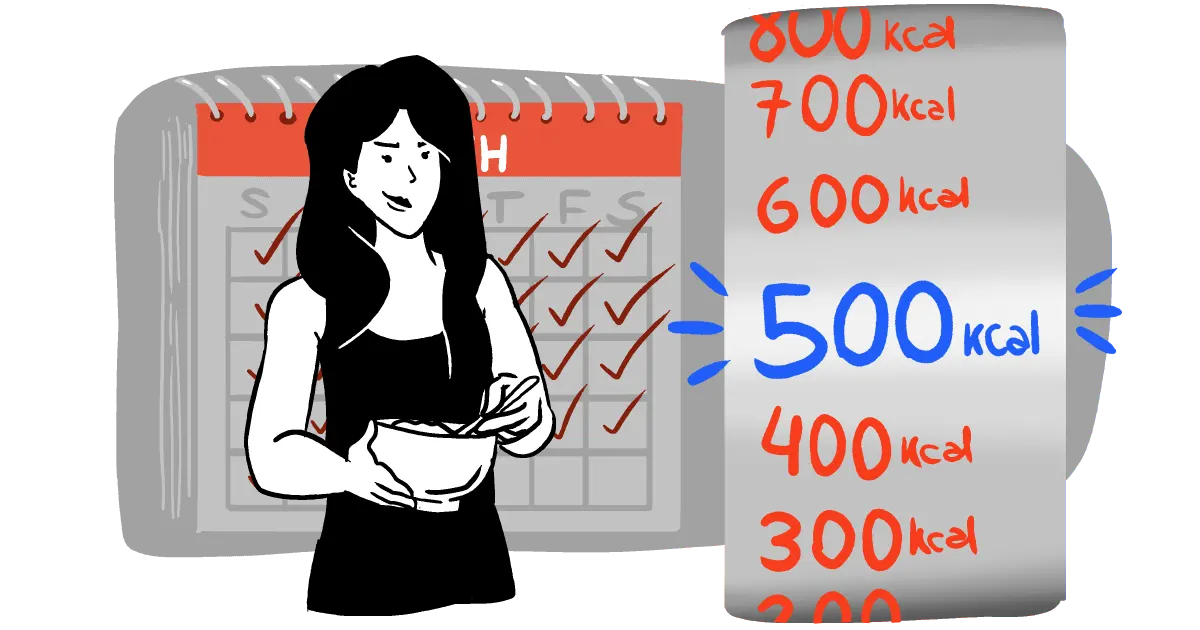
Table of Contents
Since ⅓ of adults in the United States are overweight, wanting to lose weight and the willingness to do anything to make that happen is admirable… even if that means only eating 500 calories a day for a month.
But if someone takes this route, how much weight can they expect to lose, and what’s the best way to stay full in the meantime?
Please note that restricting calories to only 500 per day puts individuals at risk of nutritional deficiencies and should only be done under the supervision of a healthcare professional.
How Much Weight Can Be Lost Eating 500 Calories a Day for a Month?
When consuming 500 calories a day for a month, weight loss can range from 8-20 pounds by the end of day 28. But it depends on the individual’s maintenance calories (amount of calories to stay at the same weight) and activity levels [2]. To put it into perspective, let’s look at an example where someone needs 2500 calories each day in order to maintain their current weight and then they reduce their calorie intake to only 500 a day (or they eat 2000 less calories per day).
Here’s the break down when considering that 3500 calories must be burned in order to lose 1 pound of fat [3]:
- Eating 2500 Calories Per Day for a Month (28 Days) = 70,000 Calories Per Month or (2500 x 28 = 70,000)
- Eating 500 Calories Per Day for a Month (28 Days) at = 14,000 Calories Per Month or (500 x 28 = 14,000)
Now, let’s subtract the two and divide by 3500 to see how many pounds can be lost per month.
- 70,000 Calories per Month – 14,000 Calories per Month = 56,000 Calorie Deficit Per Month
- 56,000 Calorie Deficit Over a Month / Calories in a Pound (3500) = 16 Pounds Lost in a Month
Of course, this doesn’t take into account activity levels but at 500 calories a day an individual will feel depleted and this will limit their physical activity.
What if I Burn More or Less Calories?
The same rough calculations can be done for those with various maintenance calories. For example, if someone’s maintenance calories are 1500 they can expect to lose about 8 pounds per month when restricting to only 500 calories. Or someone who’s maintenance calories is 3000 can expect to lose 20 pounds after a month of eating 500 calories per day.
Although, it’s important to note that these are rough estimates and it’s not recommended to drop below 5-15% body fat. So if any dieter is looking to lose weight quickly, restricting food is a tempting option that can work, but it’s not recommended.
There are other, less restrictive options to consider when looking for information on how to lose weight fast in 2 weeks,
How Can I Stay Feeling Full on 500 Calories a Day?
Only eating 500 calories a day for a month is generally not recommended; however, there are instances where professionals like Dr. Nowzaradan may recommend limiting calories as low as 1200 – 500. In this case, it’s key to know which foods help increase feelings of fullness.
Foods that increase feelings of fullness are typically high protein and high fiber foods that have a low glycemic index (measure of how fast a food raises blood sugar) [4] [5]. Carbohydrates such as sugar, bread and flour tortillas are high on the glycemic index level, causing a rapid rise in blood sugar and levels of hunger.
Whereas low glycemic index carbohydrates only cause a slow rise in blood sugar which makes them slower to digest and prolongs satiety, or feelings of fullness [6].
Examples of foods that are high in fiber and low on the glycemic index include [7]:
- Steel-cut oatmeal
- Berries
- Cruciferous vegetables (Broccoli, Cauliflower)
- Low-fat milk
- Apples
- Cashews or Peanuts
- Beans
Examples of food that are high in protein include:
- Greek yogurt
- Eggs
- Fish
- Chicken
500 Calories a Day Diet Plan

When eating 500 calories a day for a month, it’s important to get as much nutrition as possible since it’s so restrictive. There’s many 500 calorie diet plans floating around on the internet, but this is far too restrictive and quick weight loss is usually short lived. Studies show that the slower individuals lose weight, the more likely they are to keep it off, so let that be motivation to avoid these extreme diets.
However, if a doctor prescribes a 500 calorie diet plan, here’s a few meal ideas.
| Day 1 | Day 2 | Day 3 |
Breakfast:
|
Breakfast:
|
Breakfast:
|
Lunch:
|
Lunch:
|
Lunch:
|
Dinner:
|
Dinner:
|
Dinner:
|
Again ,there are several other ways to lose weight considered safer and it’s possible to learn how to jump-start weight loss safely or without the risks of severe caloric restriction.
What if You Eat Only 500 Calories a Day? (Health Implications)
By wondering, “If you starve yourself, how long to lose weight“, you may be putting yourself at risk of:
- Nutrient deficiencies: Restrictive dieting often leads to nutrient deficiencies. An example is an electrolyte imbalance as a result of reduced caloric intake. The result is the dieter being at risk for heart arrhythmias and weakened bones due to a lack of electrolytes [8].
- Physical Consequences: Loss of energy levels and slowed cognition are just a few of the physical effects found to occur with restrictive dieting [8].
- Eating disorders: Restrictive dieting itself does not necessarily cause an eating disorder, but the constant calorie counting and concern about food can lead to obsessive patterns [8].
Regardless of how fast weight is lost or the risks involved, knowing there is a possibility of nutrient deficiencies, physical consequences, and eating disorders if calories are restricted can shine light on many fad diets. Any individual’s calorie intake should not fall below 1200 calories per day in women and 1500 calories per day in men [9].
Though 500 calories per day seems to be a great way for new dieters to jump-start their weight loss, there are safer weight loss diets for beginners that do not have the dangerous health implications.
FAQ
Additional questions that frequently come up regarding caloric intake include:
- Is 500 calories a lot for a meal?
This depends on the individual and their required maintenance calories. If a person requires 2500 calories per day for maintenance and they eat three 500 calorie meals, they would be under their maintenance level. In this case 500 calories would not be a lot for one meal.
- Is eating 500 calories a day considered fasting?
A fasting state occurs when calorie consumption is less than or equal to 25% [10]. For a woman consuming 1200 calories per day, this is 300 calories or less. For a man consuming 1500 calories, this is 375 calories. Consuming 500 calories per day would not be considered fasting.
- Is a 500 Calorie Deficit Too Much?
To lose 1-2 pounds per week (considered a safe weight loss) dieters should reduce their daily food intake by 500-1000 calories. For example, if a dieter’s maintenance calorie level is 2500 calories, to lose 1 pound per week they would reduce their daily caloric intake to 2000 calories.
- What’s the minimum amount of calories you should eat?
It is recommended for women to eat a minimum of 1200 calories per day and men a minimum of 1500 calories per day [9]. The only time this guidance should not be followed is under the supervision of a medical professional.
Eating 500 calories a day for a month is not considered a safe or healthy way to lose weight. Despite the potential for rapid weight loss, there are negative health implications that indicate this is an unsafe method of weight loss.
As tempting as it can be to restrict calories for a quick weight loss, it is important to set realistic goals for weight loss and understand successful diets involve slow and steady changes [11].
References
[1] U.S. Department of Health and Human Services. (n.d.). Overweight & Obesity Statistics. National Institute of Diabetes and Digestive and Kidney Diseases. Retrieved February 2, 2022, from https://www.niddk.nih.gov/health-information/health-statistics/overweight-obesity
[2] U.S. Department of Health and Human Services. (n.d.). Overweight & Obesity Statistics. National Institute of Diabetes and Digestive and Kidney Diseases. Retrieved February 2, 2022, from https://www.niddk.nih.gov/health-information/health-statistics/overweight-obesity
[3] I want to lose a pound of weight. How many calories do I need to burn? NAL. (n.d.). Retrieved February 2, 2022, from https://www.nal.usda.gov/legacy/fnic/i-want-lose-pound-weight-how-many-calories-do-i-need-burn
[4] Njike, V. Y., Smith, T. M., Shuval, O., Shuval, K., Edshteyn, I., Kalantari, V., & Yaroch, A. L. (2016, September 15). Snack Food, satiety, and weight. Advances in nutrition (Bethesda, Md.). Retrieved February 2, 2022, from https://www.ncbi.nlm.nih.gov/pmc/articles/PMC5015032/
[5] U.S. National Library of Medicine. (n.d.). Glycemic index and diabetes: Medlineplus medical encyclopedia. MedlinePlus. Retrieved February 2, 2022, from https://medlineplus.gov/ency/patientinstructions/000941.htm
[6] Wilde, P. J. (2009, March 1). Eating for life: Designing Foods for Appetite Control. Journal of diabetes science and technology. Retrieved February 2, 2022, from https://www.ncbi.nlm.nih.gov/pmc/articles/PMC2771510/
[7] A good guide to good carbs: The glycemic index. Harvard Health. (2021, November 16). Retrieved February 2, 2022, from https://www.health.harvard.edu/healthbeat/a-good-guide-to-good-carbs-the-glycemic-index
[8] Osilla, E. V. (2021, September 15). Calories. StatPearls [Internet]. Retrieved February 2, 2022, from https://www.ncbi.nlm.nih.gov/books/NBK499909/
[9] Calorie counting made easy. Harvard Health. (2020, July 11). Retrieved February 2, 2022, from https://www.health.harvard.edu/staying-healthy/calorie-counting-made-easy
[10] Stockman, M.-C., Thomas, D., Burke, J., & Apovian, C. M. (2018, June). Intermittent fasting: Is the wait worth the weight? Current obesity reports. Retrieved February 3, 2022, from https://www.ncbi.nlm.nih.gov/pmc/articles/PMC5959807/
[11] Koliaki, C., Spinos, T., Spinou, Μ., Brinia, Μ.-E., Mitsopoulou, D., & Katsilambros, N. (2018, June 28). Defining the optimal dietary approach for safe, effective and sustainable weight loss in overweight and obese adults. Healthcare (Basel, Switzerland). Retrieved February 3, 2022, from https://www.ncbi.nlm.nih.gov/pmc/articles/PMC6163457/